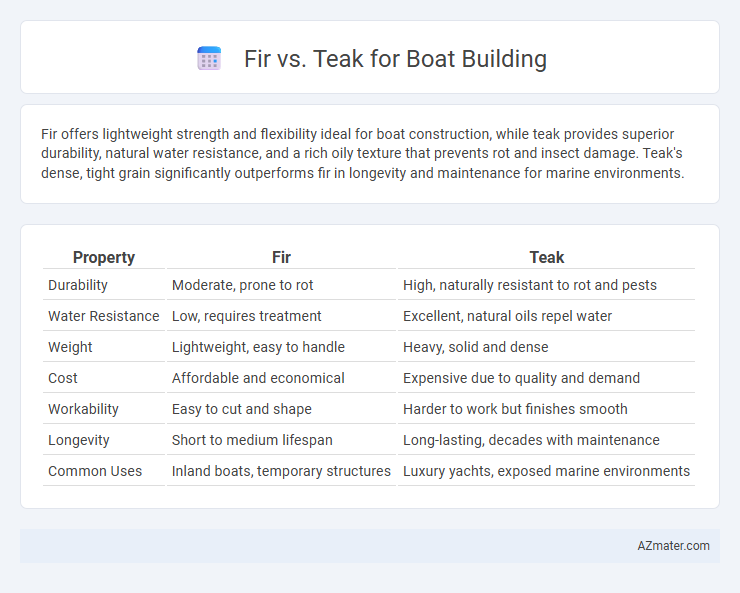Fir offers lightweight strength and flexibility ideal for boat construction, while teak provides superior durability, natural water resistance, and a rich oily texture that prevents rot and insect damage. Teak's dense, tight grain significantly outperforms fir in longevity and maintenance for marine environments.
Table of Comparison
| Property | Fir | Teak |
|---|---|---|
| Durability | Moderate, prone to rot | High, naturally resistant to rot and pests |
| Water Resistance | Low, requires treatment | Excellent, natural oils repel water |
| Weight | Lightweight, easy to handle | Heavy, solid and dense |
| Cost | Affordable and economical | Expensive due to quality and demand |
| Workability | Easy to cut and shape | Harder to work but finishes smooth |
| Longevity | Short to medium lifespan | Long-lasting, decades with maintenance |
| Common Uses | Inland boats, temporary structures | Luxury yachts, exposed marine environments |
Introduction: Comparing Fir and Teak for Boat Building
Fir and teak are two popular wood choices in boat building, each offering distinct qualities that influence performance and durability. Fir is valued for its lightweight nature, straight grain, and affordability, making it suitable for constructing large frames and structural components. Teak stands out for its exceptional resistance to water, decay, and marine borers, combined with natural oils that provide longevity and a luxurious finish ideal for decking and trim.
Overview of Fir Wood in Marine Applications
Fir wood is valued in marine applications for its straight grain, light weight, and excellent strength-to-weight ratio, making it suitable for boat frames and structural components. Its natural resistance to decay and ability to withstand moisture exposure enhance durability in harsh marine environments. Compared to teak, fir is more affordable but typically requires protective coatings to improve long-term resistance against water and UV damage.
Teak Wood: The Gold Standard for Boats
Teak wood, renowned as the gold standard for boat building, offers exceptional durability, natural oil content, and resistance to water, rot, and pests, making it ideal for marine environments. Its dense grain structure and high tensile strength provide superior structural integrity and aesthetic appeal compared to fir, which is less resistant to moisture and requires more maintenance. The premium qualities of teak, including its ability to withstand harsh saltwater conditions without warping or cracking, justify its higher cost and preference among professional boatbuilders.
Durability and Longevity: Fir vs Teak
Teak wood exhibits superior durability and longevity in boat building due to its high natural oil content, which resists water, rot, and pests effectively. Fir, while more affordable, lacks the inherent oils that provide teak with exceptional resistance, leading to a shorter lifespan and increased maintenance requirements. Boats constructed with teak typically endure harsh marine environments longer, making teak a preferred choice for long-lasting boat structures.
Resistance to Water and Rot
Fir wood offers moderate resistance to water and decay but requires protective treatments to enhance its durability in marine environments. Teak wood naturally contains oils and dense grain structures that provide superior resistance to water, rot, and marine borers, making it highly favored for boat building. The inherent rot-resistant properties of teak ensure longevity and reduced maintenance compared to fir in consistently wet and harsh conditions.
Workability and Ease of Maintenance
Fir offers excellent workability due to its straight grain and soft texture, making it easier to cut, shape, and fasten during boat building. Teak, while denser and harder, provides superior resistance to rot and marine organisms, reducing long-term maintenance needs significantly. The natural oils in teak enhance its durability and water resistance, whereas fir requires regular sealing and treatment to prevent decay and extend its lifespan.
Cost Comparison: Fir vs Teak
Fir wood offers a significantly lower cost option compared to teak for boat building, making it ideal for budget-conscious projects. Teak's higher price reflects its exceptional durability, natural resistance to water and pests, and low maintenance requirements. Choosing fir can reduce initial expenses, but teak's long-term value often justifies the premium due to its superior performance and longevity in marine environments.
Environmental Impact and Sustainability
Fir and teak differ significantly in environmental impact and sustainability for boat building. Fir, primarily sourced from fast-growing temperate forests, is more renewable and has a lower carbon footprint due to shorter growth cycles and local availability in many regions. Teak, prized for its durability and water resistance, is often harvested from tropical forests where deforestation and habitat loss pose severe ecological risks, making sustainably certified teak (FSC or PEFC) crucial for reducing environmental harm.
Best Uses for Fir and Teak in Boat Construction
Fir wood is prized in boat building for its lightweight strength, durability, and resistance to warping, making it ideal for framing, planking, and structural components in smaller or freshwater vessels. Teak offers exceptional natural oils and dense grain, providing superior resistance to water, rot, and marine organisms, which makes it the preferred choice for decking, trim, and high-quality luxury yachts. Fir is best suited for cost-effective, sturdy frameworks, while teak excels in exposed, high-wear areas requiring long-term durability and aesthetic appeal.
Choosing the Right Wood for Your Boat Building Project
Fir offers exceptional strength-to-weight ratio and is highly resistant to shrinking and warping, making it ideal for structural components in boat building. Teak boasts superior natural oils and dense grain, providing unmatched durability and resistance to water, rot, and marine organisms, perfect for decking and exterior surfaces. Selecting fir or teak depends on whether the priority is lightweight structural integrity or long-lasting, low-maintenance exterior finish.

Infographic: Fir vs Teak for Boat Building
 azmater.com
azmater.com